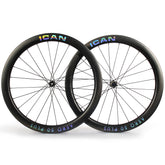The Ultimate Bike Stem Guide: Everything You Need to Know
introduction
While the stem is often overlooked, it plays a crucial role in the fit and handling of your road bike. As a link between the driver and the front wheel, it influences the position, control and driving characteristics.
A stem that is too long, too short, too steep or too flat can have a negative impact on whether your body feels constrained or overloaded. Because it can subtly change the way you ride, choosing the right model requires understanding how factors like length, angle, and materials fit with your body measurements and riding needs.
Since there are different stem designs, precise adjustment to individual ergonomics and riding style is the key to unlocking the performance potential of a bike. In this guide you'll find information about stems to help you find the crucial connection between your bike and your body. Your perfect fit starts here.
stem construction basics
The main function of the stem is to connect the handlebars of your bike to the steerer tube and therefore to the rest of the bike.
With materials, lengths, angles, and incline and decline specifications to consider, precise stem tuning is critical to the optimal fit and riding dynamics of your bike. A wise choice ensures an ergonomic interface between operator and machine.

Credit from merlincycles
material of the stem
Aluminum alloys are the most common material for low- to mid-range stems, while carbon fiber models are available for the high-end market. These models are particularly popular with racing drivers on and off the road.
Brands that offer their own integrated systems are more likely to use carbon. Carbon is preferred over aluminum due to its ability to easily create complex shapes and internal cable routing. One-piece handlebars/stems in particular are almost always made of carbon. Carbon fiber is also used on oversized stems to increase rigidity.
stem length
Stem size, measured from the center of the fork steerer to the center of the handlebars, has a significant impact on the bike's handling.
A shorter stem typically results in a faster ride, while a longer stem allows for a slower, more predictable ride.
Mountain bike stems are typically between 50 and 80 mm long, while road bike stems are longer, starting at around 80 mm and increasing to 120 mm or longer as the frame size increases. Stems for gravel bikes generally fall into the spectrum of these two types of bikes.
If you feel stretched while cycling, a shorter stem can help you reduce your reach and achieve a more upright position. However, if you feel restricted, you can increase the reach by using a slightly longer stem.

Credit from bbbcycling
shaft diameter
The diameter of the handlebar to which the stem is clamped is called the handlebar clamp diameter. Modern road bike handlebars usually have a diameter of 31.8 mm in the middle, while older handlebars usually have a diameter of 25.4 mm. For mountain bikes, the usual diameter is 31.8 mm, but there are also handlebars with a diameter of 35 mm. To determine the size of the handlebar clamp, you can use a tape measure or ruler. It should be easy to see which of these diameters it is.

Credit from bbbcycling
stem angle
Bicycle stems have different angles. While few have a 0 degree stem angle, most have an angle between 6 and 18 degrees. However, some stems have even larger angles. One of the reasons for an angled stem is that it runs parallel to the ground and gives the bike a good look. The reason for this is that the steerer tube on bicycles is already angled.
If you prefer a lower riding position, choose a stem with a negative slope. This reduces the height of the handlebars in relation to the ground. On the other hand, if you prefer a more upright position, a positive slope stem will be more comfortable to ride.

Credit from bbbcycling
spindle adjustment
There are usually spacers above the headset that allow you to adjust the height of your handlebars by raising or lowering the stem. If you leave the steerer longer initially, you can easily adjust the height of the stem by moving the spacers from top to bottom.
You can adjust the angle of your handlebars by rotating them in the stem clamp if your bike has separate handlebars and stem.
If you are using a road bike or gravel bike with folding handlebars, turning the handlebars changes the angle at which the handlebars and shift/brake levers sit.
If your bike's fork is either too loose or too tight in the frame, you can adjust it using the following steps. First loosen the screws on the stem. Then make sure the bearings have no play but still rotate smoothly and preload them to the correct height. Finally, tighten the stem again to keep everything in place. This should help you achieve the desired strength for your bike's fork.

Credit from funnmtb
How to choose
For recreational cyclists, weight and clamp shape should not play a major role. An 80mm or shorter stem that fits your handlebars should be sufficient. Check out the sales to see if you can get a bargain.
Regular riders, on the other hand, should try to use a stem that is as short as the bike frame's top tube allows before it gets too tight. Many riders have enjoyed the immediate handling benefits of a 60-70mm stem.
For road cyclists, heavy stems should be avoided and stiffness should be one of the most important features to look for in a stem. CNC stems should be considered, and expensive racers should opt for carbon stems. The new 35mm standard can also be considered, but new handlebars would also have to be purchased.






